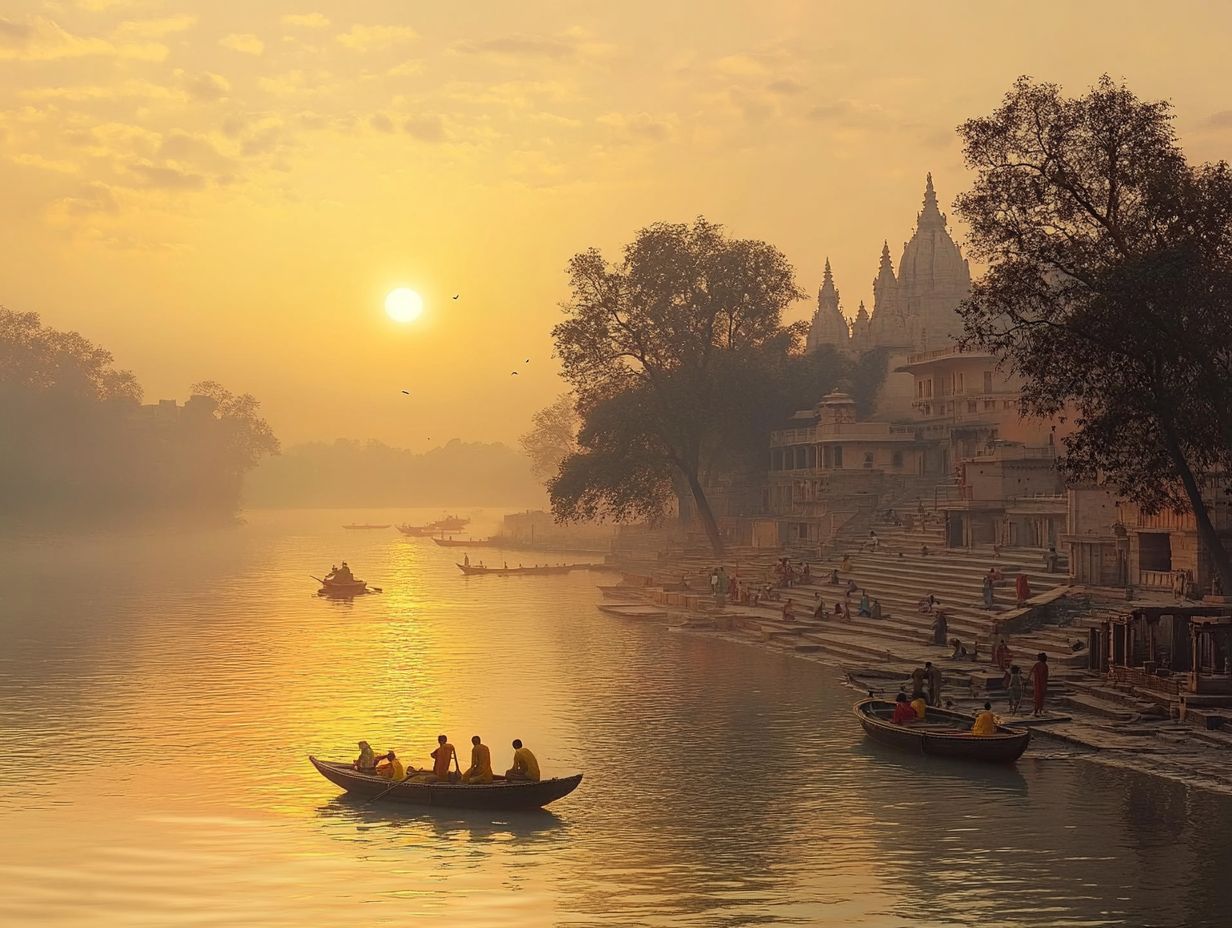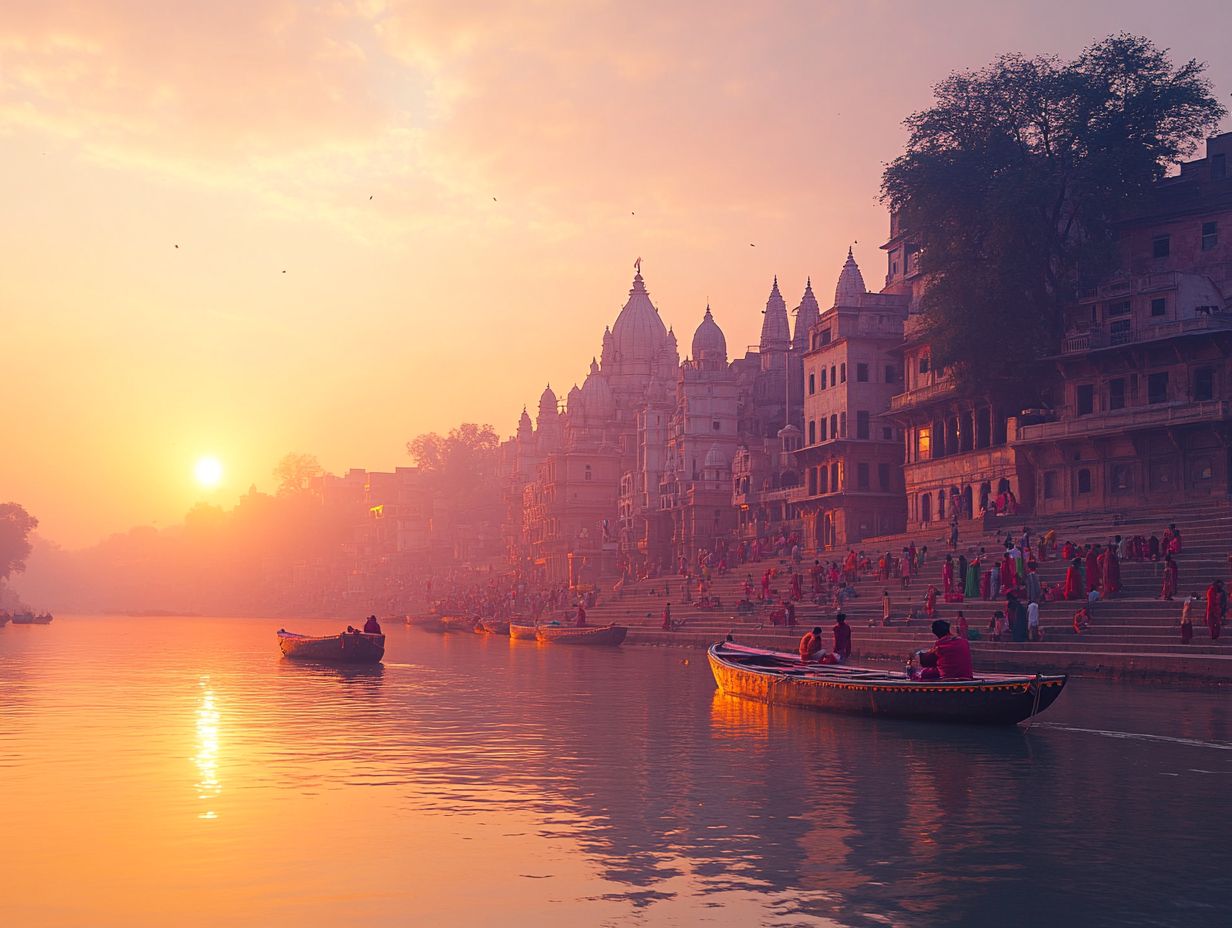Why is the River Ganges Important to Hinduism?
The River Ganges, commonly known as “Ganga,” carries profound significance in Hinduism and extends its influence beyond, weaving together the spiritual, historical, and environmental dimensions of Indian culture, becoming a central pillar of religious significance, cultural heritage, and spiritual journeys.
Esteemed as a sacred river, the Ganges embodies a rich tapestry of myths and rituals, serving as a vital lifeline for millions, influencing daily life, religious texts, and spiritual practices.
This exploration delves into its geographical and historical importance, spiritual symbolism, cultural impacts, and the pressing challenges it currently faces, such as pollution and water quality, illustrating why this river transcends the mere definition of a body of water.
Geographical and Historical Significance

The River Ganges, a revered embodiment of sacredness in Hinduism, stretches an impressive 2,525 kilometers across northern India, functioning as an critical lifeline for millions while presenting a rich tapestry of geographical features, historical significance, and serving as a symbol of life and renewal.
Meandering through the plains of northern India, this hallowed waterway has profoundly influenced the cultural identity and religious practices of the region, particularly in cities like Varanasi, where rituals of spiritual cleansing, including the holy dip, draw countless pilgrims seeking purification and moksha.
The Ganges basin, with its diverse ecosystems and sacred geography, plays a crucial role in agriculture and has been the sustenance of ancient civilizations that have flourished along its banks for centuries.
1. Location and Physical Features
The River Ganges is celebrated for its remarkable physical features, ranging from the majestic peaks of the Himalayas to the lush, fertile plains that foster vibrant ecosystems. This river is a crucial component of India’s geographical landscape.
Originating from the sacred Gangotri Glacier, the Ganges flows over a distance of approximately 2,525 kilometers, traversing a diverse array of terrains before ultimately merging with the Bay of Bengal. Along its journey, it is joined by several significant tributaries, including the Yamuna and the Ghaghara, which enhance the river s volume and richness. The Ganges basin nurtures a plethora of ecological niches, supporting diverse wildlife such as the Ganges river dolphin and an array of bird species. Moreover, the Ganges Delta is a vital area for biodiversity and ecological balance.
Beyond its physical presence, the Ganges holds profound spiritual significance for millions of devotees. It serves as a vital lifeline for the communities that depend on its waters for agriculture, daily life, and cultural practices, highlighting the deep connection between the river s natural essence and the human experience.
2. Historical Events and Legends
The history of the River Ganges is intricately woven with a multitude of historical events and legends from Hindu mythology. It is often portrayed in sacred texts as a divine entity that embodies purity and faith.
For centuries, this river has been the lifeblood of ancient civilizations, providing essential sustenance to flourishing communities that recognized its profound significance. The Ganges has served as a backdrop for pivotal moments in history, from the establishment of powerful kingdoms to the emergence of spiritual leaders who sought solace in its waters, often regarded as an eternal river symbolizing the continuity of life.
One cannot overlook the rich tapestry of religious practices that have developed along its banks, where pilgrims embark on sacred journeys to cleanse their souls and pay homage to Ganga Ma. The mythical narratives surrounding her birth and voyages further enhance its spiritual allure, transforming the Ganges into more than just a geographical feature; it stands as a revered symbol of renewal and hope within Hindu beliefs, deeply embedded in Hindu philosophy and consciousness.
The Ganges in Hinduism
In Hinduism, the Ganges is venerated as a Sacred River, symbolizing the very essence of spirituality. It serves as a central pillar for countless rituals and ceremonies, reflecting the profound faith and devotion of millions of worshippers who are drawn to its banks in search of solace and connection to the divine.
1. The Ganges as a Sacred River
The Ganges is often regarded as the holiest of rivers in Hinduism, embodying faith and serving as a vital conduit for spiritual purification and cleansing rituals that deepen the connection to its sacred waters.
For millions, bathing in the Ganges transcends mere physicality; it is a profound spiritual journey believed to wash away sins and bestow moksha, or liberation from the cycle of rebirth. The river is steeped in mythology, with countless legends intertwining its essence with deities and cosmic energies, fostering a deep reverence among its devotees, who often engage in rituals for life events and daily offerings.
Along its banks, vibrant rituals unfold daily, ranging from the mesmerizing aarti ceremonies at dawn to the serene meditations at sunset, each offering a unique blend of devotion and reflection. Every ritual performed serves as a testament to the intricate cultural fabric woven by the Ganges, linking generations and enriching the spiritual landscape of the region.
2. The Ganges in Hindu Mythology
In Hindu mythology, the Ganges is personified as Ganga Ma, a venerated goddess whose stories unfold in sacred texts, embodying the divine flow of life and the profound connection between the earth and the heavens.
The narratives surrounding Ganga Ma unveil her origins as a celestial river that descended from the heavens, symbolizing purity, knowledge, and redemption. Devotees, in their quest for her blessings, frequently immerse themselves in her sacred waters, firmly believing in her transformative power to cleanse sins and bestow spiritual liberation, with rituals often accompanied by ancestral prayers and offerings.
These tales encompass Ganga Ma’s interactions with various deities and legendary figures, illustrating her pivotal role in significant events, such as the river’s descent through the matted hair of Lord Shiva. Such themes not only accentuate her divinity but also reinforce the deep reverence felt by millions who regard her as a wellspring of life and a beacon of hope in Hindu mythology.
3. Rituals and Ceremonies Associated with the Ganges

Rituals and ceremonies associated with the Ganges, such as the Ganga Aarti, emerge as profound expressions of devotion, underscoring the river’s fundamental role in spiritual cleansing, pilgrimage traditions, and festivals. These sacred practices draw millions of devotees to the riverbanks, where the flowing waters are believed to wash away sins and bestow liberation.
The Ganga Aarti, particularly when held at dusk in Varanasi, presents a striking tableau. Candles and flowers gracefully float down the river while priests chant mantras, conjuring a divine ambiance that captivates both locals and tourists.
Beyond the realm of individual purification, the Ganges cultivates a sense of community, as people unite to perform rituals, share stories, and offer prayers. This collective engagement not only reinforces their shared beliefs and customs but also enriches the river’s significance within the intricate tapestry of Hindu culture, facilitating personal spiritual journeys while simultaneously strengthening communal bonds. The river’s banks are lined with ashrams and temples, where sadhus and devotees gather for worship and spiritual enlightenment, contributing to the overall cultural heritage.
Spiritual Significance of the Ganges
The spiritual significance of the Ganges extends far beyond its physical presence, embodying profound meanings of purification and healing that resonate deeply within the beliefs and practices of countless devotees, contributing to its status as a holy site.
This revered river serves as a powerful symbol of renewal, reflecting the deep-seated spiritual traditions that have flourished along its banks for centuries.
1. Purification and Healing Properties
The Ganges is widely revered as a source of holy water, believed to possess extraordinary purification and healing properties that cleanse both body and soul during religious rituals.
Devotees flock to its banks, particularly during auspicious events such as the Kumbh Mela, where the act of immersing oneself in its sacred waters takes on heightened significance. Many individuals recount transformative experiences, sharing how the river’s waters not only revitalized their physical health but also deepened their spirituality. Rituals like ‘Snan’ involve bathing in the river to wash away sins and rejuvenate one’s spirit, and countless testimonials reflect the profound sense of peace and clarity that follows. Pilgrimage routes leading to the river are dotted with sacred sites, emphasizing the river’s role in fostering spiritual journeys.
For these devotees, the Ganges transcends its identity as a mere river; it embodies hope, rebirth, and an enduring connection to the divine.
2. The Ganges as a Source of Spiritual Enlightenment
The Ganges has long been esteemed as a powerful wellspring of spiritual enlightenment, drawing individuals who seek a divine connection through meditation and introspection along its tranquil banks. Its spiritual energy is palpable, with Bhakti and Vedanta philosophies deeply rooted in the daily practices of those who visit.
As dawn breaks, bathing the flowing waters in a golden glow, countless seekers converge to engage in their rituals, finding comfort in the rhythmic cadence of the water lapping against the shore. The river provides a backdrop for transformative experiences, where individuals from diverse backgrounds share their narratives of growth, spiritual awakening, and self-discovery.
Among them is a young artist who discovered clarity in her purpose while meditating by the river, inspiring her to express her newfound enlightenment through vibrant paintings. Likewise, a retired teacher contemplates how his daily meditations have reshaped his values, fostering a deeper compassion for others. Both stories highlight the river’s role in facilitating personal growth and consciousness.
The Ganges, with its sacred essence, continues to nurture these profound journeys, serving as both a mirror and a guide for those who dare to embark on the path of self-discovery and spiritual awakening.
Environmental and Cultural Importance
The Ganges holds immense environmental and cultural significance that extends well beyond its status as a sacred river. It plays a pivotal role in the ecosystem while serving as a cornerstone of cultural identity and religious significance for the communities that flourish along its banks.
1. Impact on Agriculture and Livelihood
The Ganges serves as a cornerstone of agriculture and livelihood, with its waters nourishing the fertile plains of the Ganges basin and sustaining the existence of millions. This revered river is the lifeblood of the region, enabling the cultivation of essential crops such as rice, wheat, and pulses staples that not only nourish local diets but also play a crucial role in the country s overall agricultural output and cultural heritage.
Local farmers place immense reliance on the seasonal flooding and irrigation the Ganges provides, employing time-honored practices to optimize their harvests. For instance, numerous communities have implemented crop rotation techniques to preserve soil fertility and mitigate pest concerns.
The economic ramifications are far-reaching; these agricultural endeavors invigorate local economies through trade, generate job opportunities, and enhance food security. It is estimated that agriculture along the Ganges supports the livelihoods of over 40% of the population in the basin, underscoring the river’s critical role in ensuring regional sustenance.
2. Preservation Efforts and Challenges

Preservation efforts for the Ganges confront a multitude of challenges, including escalating river pollution and environmental concerns that jeopardize the delicate equilibrium of the Ganges ecosystem and the well-being of nearby communities. The river’s sustainability is critical for maintaining its ecology.
Initiatives such as the Ganga Action Plan endeavor to rejuvenate the river’s vitality through the implementation of sewage treatment systems and the promotion of sustainable waste management practices. However, the efficacy of these programs is frequently compromised by the rapid pace of urbanization, which leads to increased waste runoff and encroachment upon riverbanks, further exacerbating environmental concerns.
Furthermore, climate change introduces a serious threat, disrupting rainfall patterns and exacerbating water scarcity.
Consequently, revitalizing the Ganges necessitates not only comprehensive policy measures but also the active involvement of local communities. This highlights the imperative for a collaborative approach to surmount these enduring challenges.
3. Influence on Art, Literature, and Music
The River Ganges has profoundly shaped the realms of art, literature, and music, acting as a muse for countless artists and writers who find inspiration in its beauty and cultural significance. This timeless river, often regarded as the lifeline of India, embodies not only ecological richness but also a deep spiritual and historical essence. Its influence extends to religious texts and mythology, where it is revered as a river goddess.
Through vivid paintings that capture its shimmering waters and flowing currents, alongside profound poetry that extols its sacredness, the Ganges emerges as a powerful symbol of life, hope, and renewal. In musical compositions, it is frequently celebrated as a source of divine inspiration and spirituality, reinforcing its pivotal role in the cultural psyche.
Collectively, these artistic interpretations underscore the river’s profound impact on societal beliefs, shaping values that resonate within the community and inspiring devotion across generations. The Ganges also plays a crucial role in various rituals of passage and pilgrimage routes, further highlighting its importance in Hinduism.
Controversies and Issues Surrounding the Ganges
The Ganges is beset by a multitude of controversies and challenges, particularly concerning pollution and water quality. These issues have ignited conflicts over water usage among the diverse stakeholders who depend on the river’s invaluable resources.
1. Pollution and Water Quality Concerns
Pollution in the Ganges has emerged as a critical issue, raising profound concerns about water quality that endanger both the river’s ecosystem and the communities reliant on it.
The origins of this pollution are diverse, with industrial waste and untreated sewage standing out as particularly harmful culprits. Factories dot the riverbanks, discharging toxic chemicals directly into the water, while urban centers contribute substantial volumes of wastewater laden with pathogens and toxins.
Such degraded water quality presents serious public health risks, resulting in waterborne diseases that predominantly impact the most vulnerable populations. Additionally, the Ganges’ rich biodiversity is at risk, as numerous aquatic species struggle to thrive in the polluted waters.
These challenges hinder preservation initiatives, complicating efforts to restore the river’s natural equilibrium and maintain its cultural significance for millions of people.
2. Conflicts Over Water Usage and Management
Conflicts surrounding water usage and the management of the Ganges have escalated, as various stakeholders including communities, industries, and agricultural sectors strive for access to this vital resource. This struggle presents a complex array of challenges for policymakers, who must adeptly navigate the competing demands for water allocated to irrigation, industrial production, and domestic consumption.
As agricultural demands intensify in response to growing populations, farmers increasingly rely on the river’s waters, while industries compete for a reliable supply to support their operations. Such competing interests often result in over-extraction and pollution, jeopardizing the delicate ecosystems sustained by the river.
Initiatives like the Ganga Action Plan seek to mitigate these issues, yet they frequently confront obstacles stemming from conflicting priorities and insufficient collaboration among stakeholders. This lack of unity complicates the journey toward sustainable management of this essential resource.
Frequently Asked Questions
Why is the River Ganges Important to Hinduism?

The River Ganges, also known as Ganga, holds immense religious and cultural significance for Hindus. It is believed to be a sacred river and plays a vital role in Hinduism for various reasons, including spirituality and rituals.
What is the significance of the River Ganges in Hindu mythology?
In Hindu mythology, the River Ganges is believed to have originated from the locks of Lord Shiva, one of the most revered deities in Hinduism. It is also said to be the path that Goddess Ganga took to descend to Earth from heaven, marking its divine presence.
How is the River Ganges connected to spiritual purification in Hinduism?
In Hinduism, it is believed that the waters of the River Ganges have the power to cleanse one’s sins and bring spiritual purification. This is why many Hindus perform rituals and ceremonies on its banks and immerse the ashes of their loved ones in its waters, seeking moksha and spiritual cleansing.
Why is taking a dip in the River Ganges considered auspicious in Hinduism?
Hindus consider taking a dip in the River Ganges as a highly auspicious act. It is believed that the water of the Ganges is not only physically purifying but also spiritually uplifting. It is believed to wash away negative energies and bring blessings to those who bathe in it, often referred to as a holy dip.
How does the River Ganges impact the daily lives of Hindus?
The River Ganges is not just a religious or spiritual symbol for Hindus, but it also holds practical significance in their daily lives. It provides water for drinking, irrigation, and transportation to millions of people living along its banks, impacting their daily life and sustenance.
What are some important festivals and rituals associated with the River Ganges in Hinduism?
The River Ganges is an integral part of many Hindu festivals and rituals. Kumbh Mela, a mass pilgrimage held every 12 years, is one such festival where millions of Hindus gather to bathe in the holy waters of the Ganges. Other rituals like offering prayers to the river during religious ceremonies and floating diyas (oil lamps) on its waters during festivals like Diwali are also common practices among Hindus. The Ganges is central to numerous ceremonies, traditions, and rituals for life events, reflecting its deep connection to the community.
